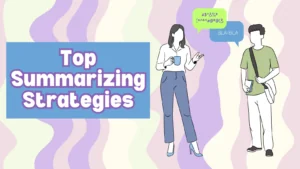In the vast landscape of writing, where words often flow endlessly, there exists an art that has the power to condense and clarify—a skill so vital that it stands at the heart of effective communication. This art is summarization, a creative and essential technique that allows writers to distill lengthy texts into concise, comprehensible forms. In this article, we embark on a journey to uncover the world of summarization, delving into its definitions, types, the summarization process, common pitfalls, and the immense potential it holds for writers.

✅ AI Essay Writer ✅ AI Detector ✅ Plagchecker ✅ Paraphraser
✅ Summarizer ✅ Citation Generator
Defining a Summary
At its core, a summary is the craft of condensing a longer text while retaining its primary message and essential information. Its fundamental purpose is to offer readers a shorter version of the original work, providing a pathway to understanding its main points without traversing every written detail.
To better understand the concept of summarizing, use our Free AI Summary Generator new tool.
“In ‘Impact of Climate Change on Coastal Ecosystems,’ the author explores the far-reaching effects of climate change on coastal environments. This comprehensive examination reveals alarming shifts in biodiversity, habitat loss, and the endangerment of unique species due to rising temperatures and sea levels. The essay serves as a clarion call for immediate conservation efforts and the adoption of sustainable practices to safeguard our vulnerable coastal regions.”
Types of Summaries
Summaries, versatile tools in communication, take on distinct forms, each tailored to specific contexts and purposes.
Informative Summaries. These summaries stand as comprehensive overviews, delving into the original work’s main arguments, supporting evidence, and conclusions. They are often used in academic settings due to their depth and detail. Informative summaries provide a thorough examination of the source material, offering a detailed exploration of its key elements. They find prominence in academic environments, where a comprehensive understanding of the original work is essential for scholarly discourse. Informative summaries not only condense information but also serve as educational tools, imparting knowledge and insights to readers.
| Informative Summary | Key Details |
| In-Depth Analysis | |
| Academic Application | |
| Educational Value |
Indicative Summaries. In contrast, indicative summaries provide a broader glimpse of the work, emphasizing the main ideas while steering clear of intricate details. They act as teasers, enticing readers with a taste of the original content. Indicative summaries aim to captivate readers’ interest by offering a glimpse into the core concepts of the source material. They prioritize brevity and clarity, avoiding exhaustive explanations to maintain reader engagement. Indicative summaries spark curiosity, encouraging readers to explore the full work to satisfy their intrigue.
| Indicative Summary | Key Details |
| Teaser Approach | |
| Concise Presentation | |
| Curiosity Provocation |
Abstracts, concise and illuminating, grace the beginnings of research papers and articles. They encapsulate the entire work, condensing its objectives, methods, results, and conclusions into a succinct form. Abstracts provide a comprehensive snapshot of the source material, encapsulating all critical aspects in a concise format. They hold particular importance in scientific and academic publications, offering a quick assessment of the study’s merits. Abstracts excel in efficient communication, allowing readers to grasp the core content quickly and decide whether further exploration is warranted.
| Abstract | Key Details |
| Comprehensive Overview | |
| Scientific and Academic Focus | |
| Efficient Communication |
The Process of Summarizing
Effective summarization is a systematic process that involves several key steps. Let’s delve into each step with examples, drawing inspiration from a fake work titled “Interpreting Symbolism in Classic Literature.”
Identify Key Points
To begin, immerse yourself in the original text, meticulously identifying its central ideas, arguments, and supporting evidence. For instance, when summarizing the work on symbolism in classic literature, pinpoint crucial recurring symbols like the green light in “The Great Gatsby” or the white whale in “Moby-Dick.”
Omit Less Relevant Details
In crafting your summary, be discerning about what to include. Concentrate on the core message and information that bolsters it. Avoid delving into lengthy character descriptions or subplots unless they significantly contribute to the overarching theme of symbolism.
Retain the Core Message
Ensure that your summary faithfully conveys the central theme or message of the original work. In the context of our literary analysis, emphasize how symbolism is employed to convey deeper meanings and themes in classic literature.
Maintain Clarity and Brevity
Craft your summary with utmost clarity and in concise language. Steer clear of convoluted sentences or intricate vocabulary that might hinder comprehension. For example, when summarizing complex symbolism theories, use clear and straightforward language to elucidate their essence.
Practice and Improve
Summarization is a skill honed through practice. Challenge yourself regularly by summarizing various texts, including different literary works. Over time, you will refine your summarization skills and become proficient at extracting the essence of complex literary analyses like “Interpreting Symbolism in Classic Literature.”
By following these steps with tangible examples, you can create summaries that are not only accurate and clear but also effectively capture the depth and complexity of the original work.
Common Mistakes in Summarizing
Summarization, a valuable skill, often leads writers into common pitfalls. These mistakes encompass over-simplification, wherein complex texts may be misrepresented due to an excessively simplified approach. Omitting important details, a second error, can result in incomplete or misleading summaries, necessitating thoroughness in incorporating pivotal facts and arguments. Furthermore, including personal opinions within summaries is discouraged, as objectivity is paramount. Finally, neglecting the core message of the original work represents a fundamental error, as the primary purpose of a summary is to effectively convey the central message. Avoiding these pitfalls requires a delicate balance between brevity and accuracy, maintaining objectivity, and preserving the author’s perspective and tone.
To sidestep these common summarization pitfalls, consider the following tips:
- Balance Brevity and Accuracy: Strive for concise summaries without oversimplification. Use clear and precise language to capture complexity.
- Incorporate Key Information: Be diligent in including pivotal facts, arguments, and supporting evidence to provide a comprehensive overview.
- Maintain Objectivity: Keep personal opinions and biases out of your summaries. Focus on presenting the author’s viewpoint objectively.
- Highlight the Central Message: Ensure your summary conveys the original work’s central theme or message clearly and effectively.
By adhering to these tips, you can craft summaries that are accurate, balanced, and true to the essence of the source material, steering clear of common summarization mistakes.
Conclusion
In the realm of writing, the art of summarization is a potent tool that enhances communication, conserves time, and renders intricate topics more accessible. Whether you are summarizing an essay, an article, or any form of written content, mastering the art of summary demands creativity, precision, and the ability to distill the essence of a text without sacrificing its core message. By understanding the types of summaries, adhering to a methodical summarization process, and sidestepping common pitfalls, you can emerge as a proficient summarizer, enriching your writing and communication abilities. Summarization, at its essence, is the art of creative brevity—a beacon that guides readers through the labyrinth of words towards clarity and understanding.
FAQ
Follow us on Reddit for more insights and updates.





Comments (0)
Welcome to A*Help comments!
We’re all about debate and discussion at A*Help.
We value the diverse opinions of users, so you may find points of view that you don’t agree with. And that’s cool. However, there are certain things we’re not OK with: attempts to manipulate our data in any way, for example, or the posting of discriminative, offensive, hateful, or disparaging material.